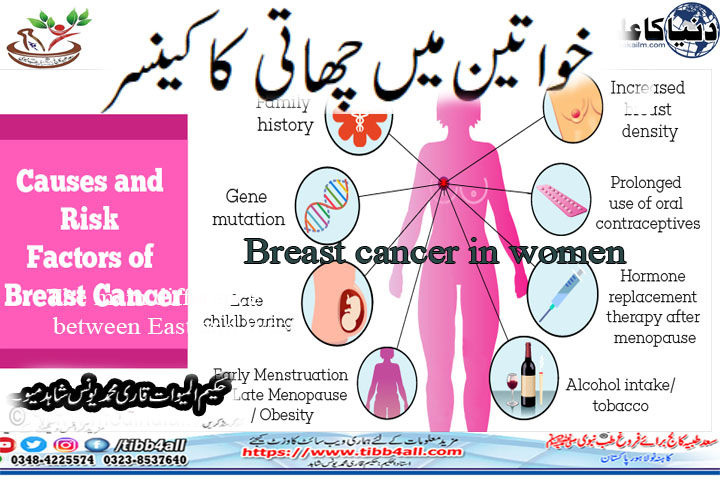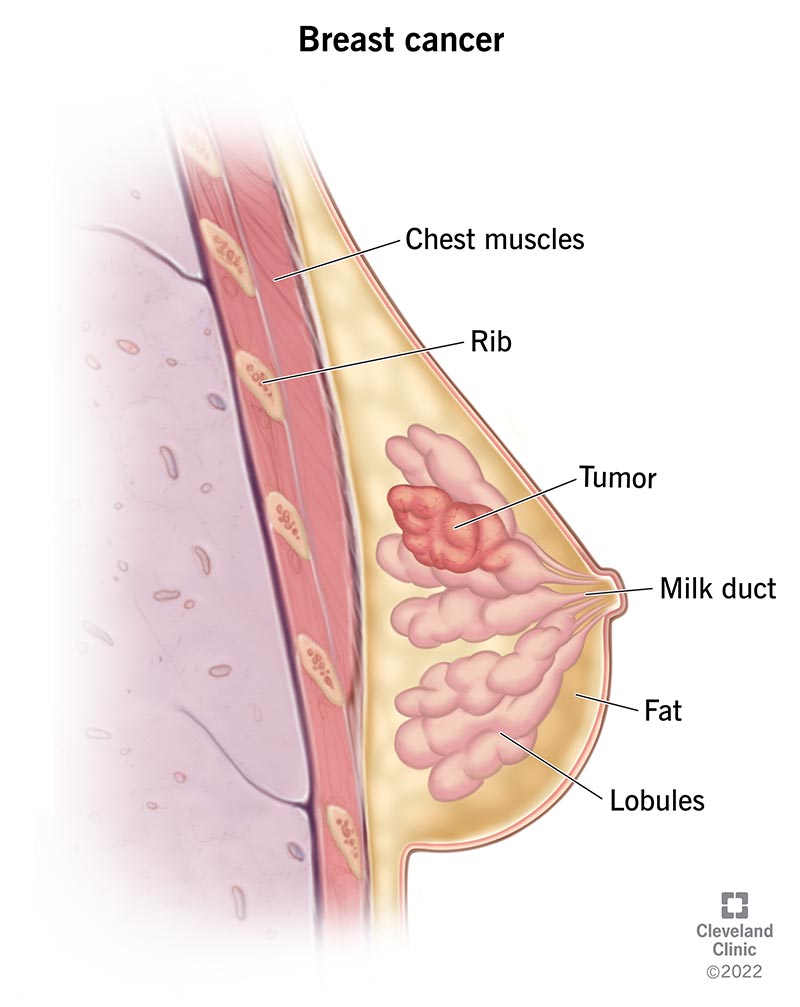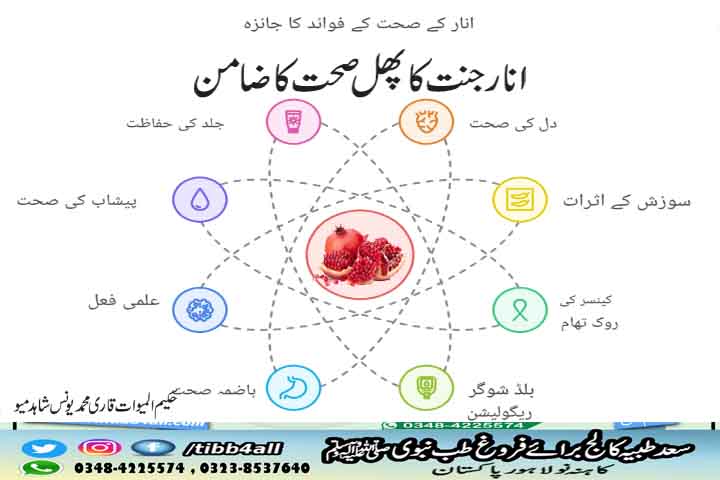
hakeem al meewat
Qari m younas shahid meo
tibb4all
dunyakailm
Saad Virtual Skills
@Tibb4allTv
۔۔۔۔۔۔۔۔۔۔۔۔۔۔۔۔۔۔۔۔۔۔۔
Breast cancer in women
Breast cancer is not a new thing. This disease has a very long history. The worrying thing is that it is seen in abundance at this time. A large number of women are suffering from this disease all over the world. Various treatments and treatments have been researched. But the final results are becoming more and more difficult. There are many examples of its treatment in indigenous methods. Many women who have been diagnosed with breast cancer have been successfully treated. Thanks to Allah, she is living a healthy life.

Unless the causes and factors of a disease are considered, it is difficult to treat and cure it. In this regard, we have written several articles on our website and a permanent book is also under preparation.
Introduction to Disease
A. Definition of breast cancer
B. Prevalence and Significance of the Problem
II Risk Factors
A. Genetic factors
B. Lifestyle factors
C. Environmental factors
III. Symptoms
A. Common symptoms of breast cancer
B. When to seek medical attention.
IV Diagnosis
A. Screening Methods
B. Diagnostic tests
V Treatment Options
A. Surgery
B. Chemotherapy
C. Radiation therapy
D. Hormonal therapy
E. Targeted therapy
VI. Treatment side effects
A. Short-term effects
B. Long-term effects
VII SUPPORT AND CONTINGENCY STRATEGIES
A. Support groups
B. Counseling
C. Lifestyle adjustments
** VIII. Prevention**
A. Lifestyle changes
B. Screening Recommendations
** IX. Advances in Research**
A. Immunotherapy
B. Personalized medicine
X. Result
A. Summary of key points
B. Importance of awareness and early detection
Detailed article: Breast cancer in women
I. Introduction
Breast cancer is a type of cancer that develops in the breast tissue, mainly affecting women, although it can also occur in men. It is a major health problem worldwide, with millions of new cases diagnosed each year.
II Risk Factors
Several factors can increase a woman’s risk of breast cancer. These include genetic predisposition, such as mutations in the BRCA1 and BRCA2 genes, as well as lifestyle and environmental factors such as obesity, alcohol use, and exposure to certain chemicals.
III. Syttps=1mptoms
Common symptoms of breast cancer include a lump or mass in the breast or underarm, changes in breast size or shape, nipple discharge, and skin changes such as redness or dimpling. It’s important to note that not all lumps are cancerous, but any changes should be evaluated by a healthcare professional immediately.
IV Diagnosis
Early detection is critical to successful breast cancer treatment. Screening methods such as mammograms and clinical breast exams can help detect cancer in its early stages. If a suspicious lump or abnormality is found, further diagnostic tests such as ultrasound, MRI, or biopsy may be done to confirm the diagnosis.
V Treatment Options
Modern medical treatment has many medicines and measures, but indigenous treatments are less painful and less expensive. Their results are also excellent. When the causes and factors are eliminated, better results can be achieved.
Breast cancer treatment varies depending on the stage and characteristics of the cancer, as well as the patient’s overall health and preferences. Common treatment options include surgery to remove the tumor, chemotherapy to kill cancer cells, radiation therapy to destroy remaining cancer cells, and hormonal therapy to block the effects of hormones that promote cancer growth. , and include targeted therapies to attack specific molecular targets in cancer cells.
VI. Treatment side effects
Although cancer treatment can be effective, it often comes with side effects that can affect quality of life. These may include fatigue, nausea, hair loss, changes in appetite, and emotional distress. Some side effects may be temporary, while others may persist long after treatment ends.
The current treatments of cancer are very painful. The above symptoms are described in less number, while in indigenous methods of treatment, one does not have to face this kind of suffering. It will be better to wait for our detailed book in this regard. It might come out this week.
VII SUPPORT AND CONTINGENCY STRATEGIES
Coping with a breast cancer diagnosis can be difficult, but there are resources available to help patients and their families through this difficult time. Support groups, counseling, and lifestyle adjustments such as exercise and stress management techniques can all play a role in improving emotional well-being and overall quality of life.
** VIII. Prevention**
Although not all cases of breast cancer can be prevented, there are steps women can take to reduce their risk. Maintaining a healthy weight, limiting alcohol consumption, exercising regularly, and avoiding exposure to known carcinogens can help reduce the risk of breast cancer.
Additionally, it is important to follow recommended screening guidelines for early detection.
** IX. Advances in Research*47*
Breast cancer research continues, new treatments and technologies are constantly being developed. Recent advances include immunotherapy, which uses the body’s immune system to target cancer cells, and personalized medicine, which tailors treatments to individual patients based on their unique genetic makeup and tumor characteristics. Develop plans.+6989

X. Result
Breast cancer remains a major public health concern, but advances in screening, diagnosis, and treatment have led to better outcomes for many patients. By raising awareness, promoting early diagnosis, and supporting ongoing research efforts, we can continue to make progress in the fight against breast cancer.
Abstract:
Breast cancer is a complex disease with multiple risk factors, symptoms, and treatment options. Early detection through screening is critical to successful treatment outcomes. While treatment can be effective, it often comes with side effects that require support and coping strategies. Prevention strategies include lifestyle changes and adherence to screening guidelines. Ongoing research continues to advance our understanding of Bri.










